Dynamic Perspectives on Sustainable Business: Analysis and Strategies
VerifiedAdded on 2023/06/11
|9
|2359
|182
Report
AI Summary
This report provides a comprehensive analysis of sustainability in business, drawing on quantitative and qualitative data to explore the sustainability activities of an organization. It critically examines literature related to sustainability concerns, models such as the Triple Bottom Line and Corporate Social Responsibility, and theories supporting business ethics and sustainable strategies. The report identifies key sustainability issues like carbon emissions, climate change, and social justice, emphasizing the importance of holistic thinking and ethical considerations. Furthermore, it evaluates sustainable business strategies across different areas, including office practices, supply chain management, and community engagement. The report concludes with recommendations for future research, highlighting the value of secondary data and its applicability in understanding and implementing sustainable business practices; solved assignments and past papers are available on Desklib.
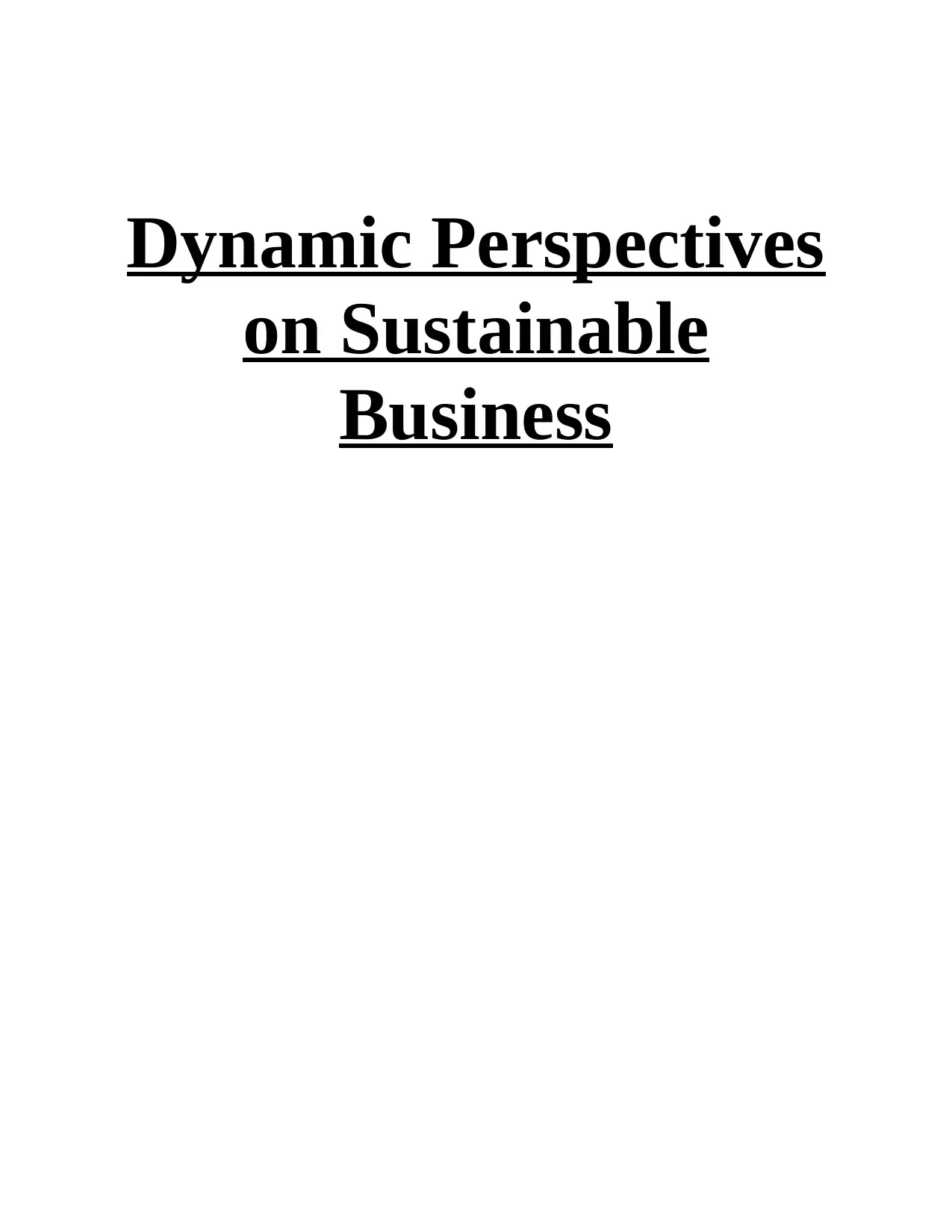
Dynamic Perspectives
on Sustainable
Business
on Sustainable
Business
Paraphrase This Document
Need a fresh take? Get an instant paraphrase of this document with our AI Paraphraser
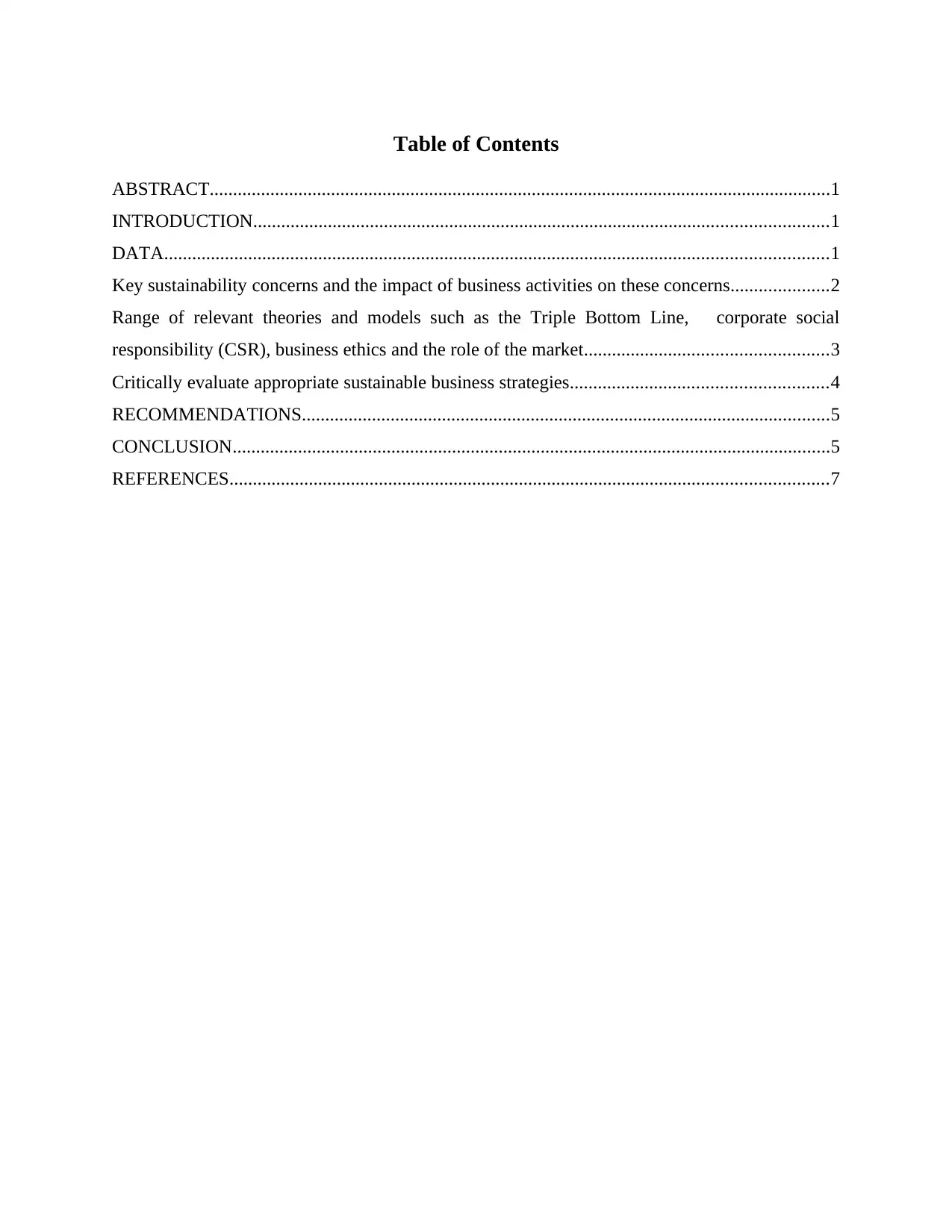
Table of Contents
ABSTRACT.....................................................................................................................................1
INTRODUCTION...........................................................................................................................1
DATA..............................................................................................................................................1
Key sustainability concerns and the impact of business activities on these concerns.....................2
Range of relevant theories and models such as the Triple Bottom Line, corporate social
responsibility (CSR), business ethics and the role of the market....................................................3
Critically evaluate appropriate sustainable business strategies.......................................................4
RECOMMENDATIONS.................................................................................................................5
CONCLUSION................................................................................................................................5
REFERENCES................................................................................................................................7
ABSTRACT.....................................................................................................................................1
INTRODUCTION...........................................................................................................................1
DATA..............................................................................................................................................1
Key sustainability concerns and the impact of business activities on these concerns.....................2
Range of relevant theories and models such as the Triple Bottom Line, corporate social
responsibility (CSR), business ethics and the role of the market....................................................3
Critically evaluate appropriate sustainable business strategies.......................................................4
RECOMMENDATIONS.................................................................................................................5
CONCLUSION................................................................................................................................5
REFERENCES................................................................................................................................7
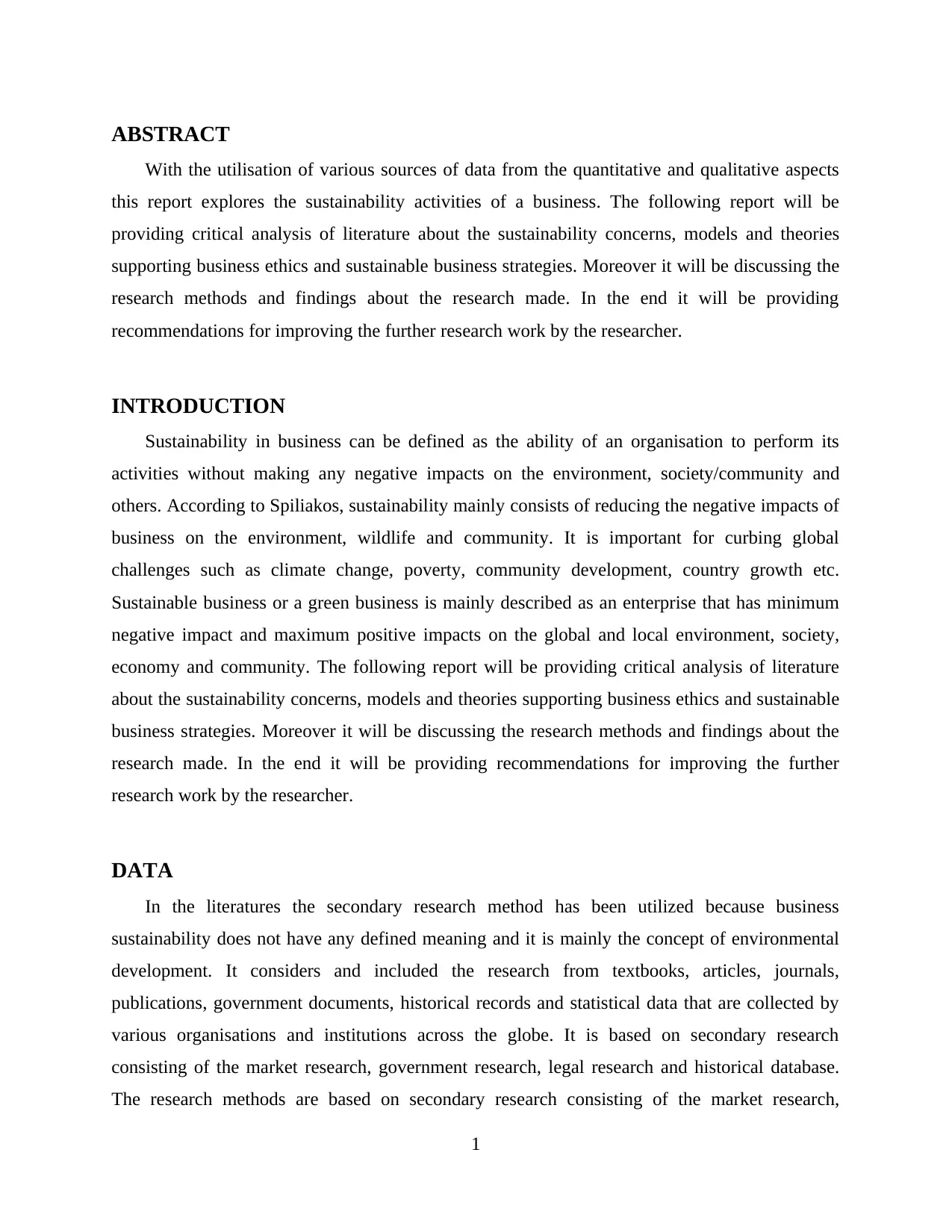
ABSTRACT
With the utilisation of various sources of data from the quantitative and qualitative aspects
this report explores the sustainability activities of a business. The following report will be
providing critical analysis of literature about the sustainability concerns, models and theories
supporting business ethics and sustainable business strategies. Moreover it will be discussing the
research methods and findings about the research made. In the end it will be providing
recommendations for improving the further research work by the researcher.
INTRODUCTION
Sustainability in business can be defined as the ability of an organisation to perform its
activities without making any negative impacts on the environment, society/community and
others. According to Spiliakos, sustainability mainly consists of reducing the negative impacts of
business on the environment, wildlife and community. It is important for curbing global
challenges such as climate change, poverty, community development, country growth etc.
Sustainable business or a green business is mainly described as an enterprise that has minimum
negative impact and maximum positive impacts on the global and local environment, society,
economy and community. The following report will be providing critical analysis of literature
about the sustainability concerns, models and theories supporting business ethics and sustainable
business strategies. Moreover it will be discussing the research methods and findings about the
research made. In the end it will be providing recommendations for improving the further
research work by the researcher.
DATA
In the literatures the secondary research method has been utilized because business
sustainability does not have any defined meaning and it is mainly the concept of environmental
development. It considers and included the research from textbooks, articles, journals,
publications, government documents, historical records and statistical data that are collected by
various organisations and institutions across the globe. It is based on secondary research
consisting of the market research, government research, legal research and historical database.
The research methods are based on secondary research consisting of the market research,
1
With the utilisation of various sources of data from the quantitative and qualitative aspects
this report explores the sustainability activities of a business. The following report will be
providing critical analysis of literature about the sustainability concerns, models and theories
supporting business ethics and sustainable business strategies. Moreover it will be discussing the
research methods and findings about the research made. In the end it will be providing
recommendations for improving the further research work by the researcher.
INTRODUCTION
Sustainability in business can be defined as the ability of an organisation to perform its
activities without making any negative impacts on the environment, society/community and
others. According to Spiliakos, sustainability mainly consists of reducing the negative impacts of
business on the environment, wildlife and community. It is important for curbing global
challenges such as climate change, poverty, community development, country growth etc.
Sustainable business or a green business is mainly described as an enterprise that has minimum
negative impact and maximum positive impacts on the global and local environment, society,
economy and community. The following report will be providing critical analysis of literature
about the sustainability concerns, models and theories supporting business ethics and sustainable
business strategies. Moreover it will be discussing the research methods and findings about the
research made. In the end it will be providing recommendations for improving the further
research work by the researcher.
DATA
In the literatures the secondary research method has been utilized because business
sustainability does not have any defined meaning and it is mainly the concept of environmental
development. It considers and included the research from textbooks, articles, journals,
publications, government documents, historical records and statistical data that are collected by
various organisations and institutions across the globe. It is based on secondary research
consisting of the market research, government research, legal research and historical database.
The research methods are based on secondary research consisting of the market research,
1
⊘ This is a preview!⊘
Do you want full access?
Subscribe today to unlock all pages.

Trusted by 1+ million students worldwide
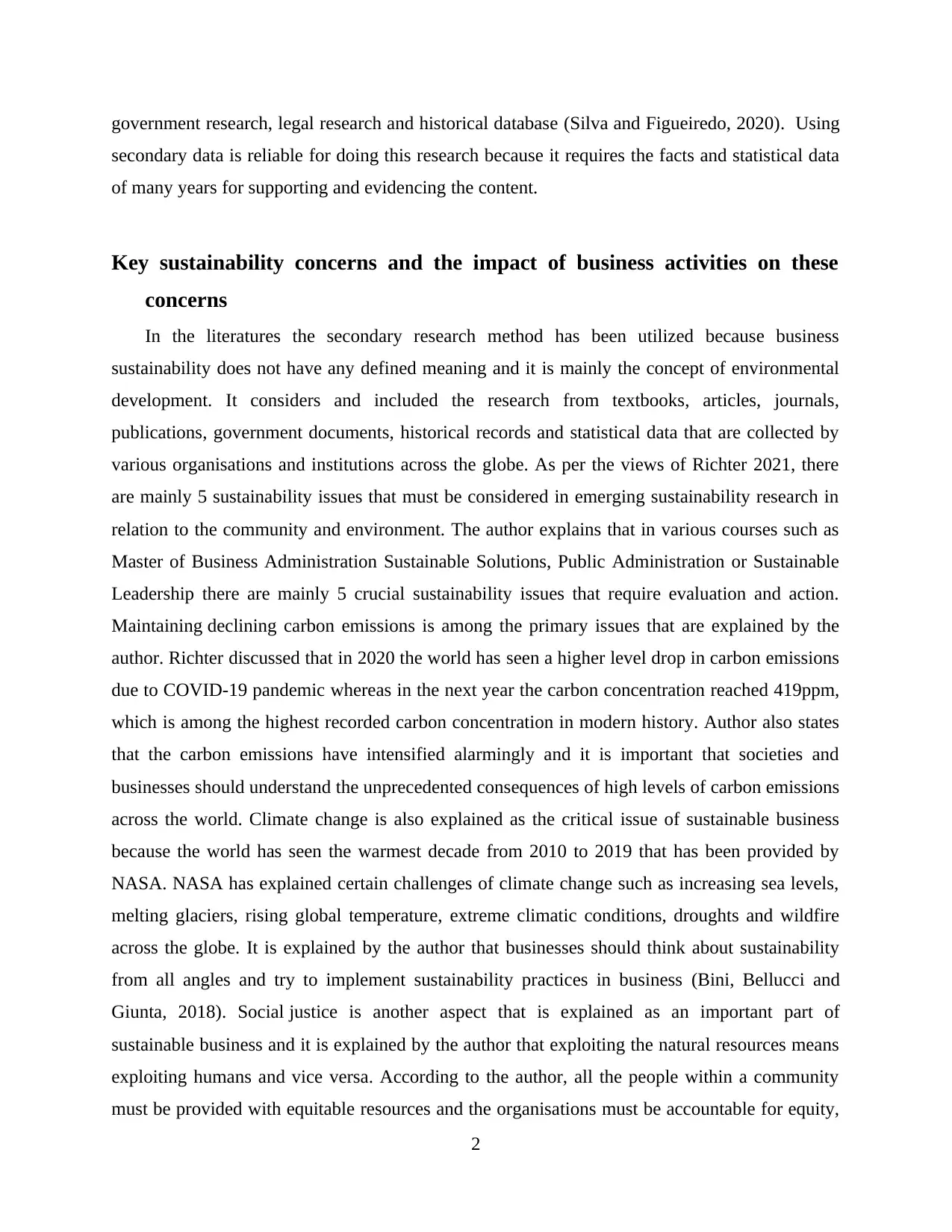
government research, legal research and historical database (Silva and Figueiredo, 2020). Using
secondary data is reliable for doing this research because it requires the facts and statistical data
of many years for supporting and evidencing the content.
Key sustainability concerns and the impact of business activities on these
concerns
In the literatures the secondary research method has been utilized because business
sustainability does not have any defined meaning and it is mainly the concept of environmental
development. It considers and included the research from textbooks, articles, journals,
publications, government documents, historical records and statistical data that are collected by
various organisations and institutions across the globe. As per the views of Richter 2021, there
are mainly 5 sustainability issues that must be considered in emerging sustainability research in
relation to the community and environment. The author explains that in various courses such as
Master of Business Administration Sustainable Solutions, Public Administration or Sustainable
Leadership there are mainly 5 crucial sustainability issues that require evaluation and action.
Maintaining declining carbon emissions is among the primary issues that are explained by the
author. Richter discussed that in 2020 the world has seen a higher level drop in carbon emissions
due to COVID-19 pandemic whereas in the next year the carbon concentration reached 419ppm,
which is among the highest recorded carbon concentration in modern history. Author also states
that the carbon emissions have intensified alarmingly and it is important that societies and
businesses should understand the unprecedented consequences of high levels of carbon emissions
across the world. Climate change is also explained as the critical issue of sustainable business
because the world has seen the warmest decade from 2010 to 2019 that has been provided by
NASA. NASA has explained certain challenges of climate change such as increasing sea levels,
melting glaciers, rising global temperature, extreme climatic conditions, droughts and wildfire
across the globe. It is explained by the author that businesses should think about sustainability
from all angles and try to implement sustainability practices in business (Bini, Bellucci and
Giunta, 2018). Social justice is another aspect that is explained as an important part of
sustainable business and it is explained by the author that exploiting the natural resources means
exploiting humans and vice versa. According to the author, all the people within a community
must be provided with equitable resources and the organisations must be accountable for equity,
2
secondary data is reliable for doing this research because it requires the facts and statistical data
of many years for supporting and evidencing the content.
Key sustainability concerns and the impact of business activities on these
concerns
In the literatures the secondary research method has been utilized because business
sustainability does not have any defined meaning and it is mainly the concept of environmental
development. It considers and included the research from textbooks, articles, journals,
publications, government documents, historical records and statistical data that are collected by
various organisations and institutions across the globe. As per the views of Richter 2021, there
are mainly 5 sustainability issues that must be considered in emerging sustainability research in
relation to the community and environment. The author explains that in various courses such as
Master of Business Administration Sustainable Solutions, Public Administration or Sustainable
Leadership there are mainly 5 crucial sustainability issues that require evaluation and action.
Maintaining declining carbon emissions is among the primary issues that are explained by the
author. Richter discussed that in 2020 the world has seen a higher level drop in carbon emissions
due to COVID-19 pandemic whereas in the next year the carbon concentration reached 419ppm,
which is among the highest recorded carbon concentration in modern history. Author also states
that the carbon emissions have intensified alarmingly and it is important that societies and
businesses should understand the unprecedented consequences of high levels of carbon emissions
across the world. Climate change is also explained as the critical issue of sustainable business
because the world has seen the warmest decade from 2010 to 2019 that has been provided by
NASA. NASA has explained certain challenges of climate change such as increasing sea levels,
melting glaciers, rising global temperature, extreme climatic conditions, droughts and wildfire
across the globe. It is explained by the author that businesses should think about sustainability
from all angles and try to implement sustainability practices in business (Bini, Bellucci and
Giunta, 2018). Social justice is another aspect that is explained as an important part of
sustainable business and it is explained by the author that exploiting the natural resources means
exploiting humans and vice versa. According to the author, all the people within a community
must be provided with equitable resources and the organisations must be accountable for equity,
2
Paraphrase This Document
Need a fresh take? Get an instant paraphrase of this document with our AI Paraphraser
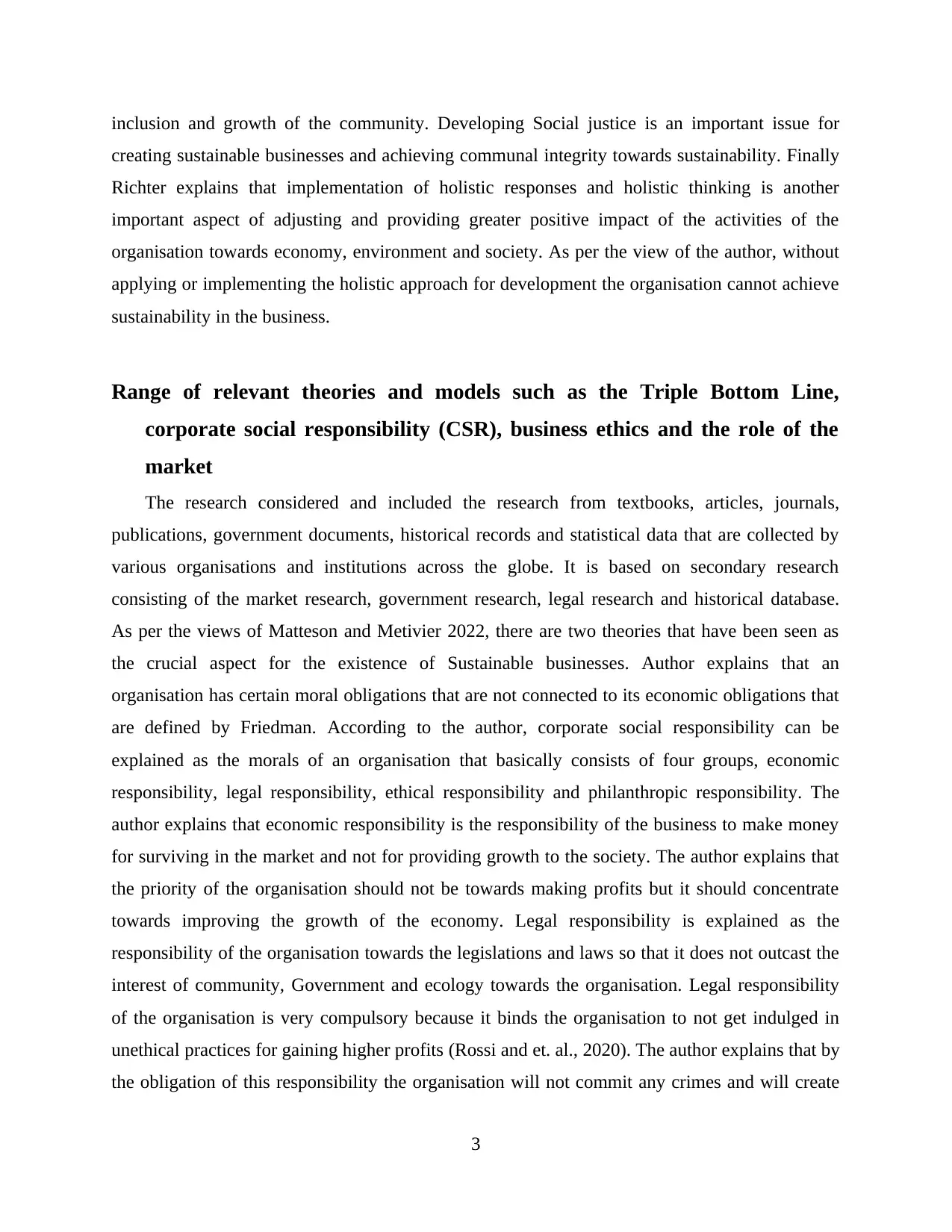
inclusion and growth of the community. Developing Social justice is an important issue for
creating sustainable businesses and achieving communal integrity towards sustainability. Finally
Richter explains that implementation of holistic responses and holistic thinking is another
important aspect of adjusting and providing greater positive impact of the activities of the
organisation towards economy, environment and society. As per the view of the author, without
applying or implementing the holistic approach for development the organisation cannot achieve
sustainability in the business.
Range of relevant theories and models such as the Triple Bottom Line,
corporate social responsibility (CSR), business ethics and the role of the
market
The research considered and included the research from textbooks, articles, journals,
publications, government documents, historical records and statistical data that are collected by
various organisations and institutions across the globe. It is based on secondary research
consisting of the market research, government research, legal research and historical database.
As per the views of Matteson and Metivier 2022, there are two theories that have been seen as
the crucial aspect for the existence of Sustainable businesses. Author explains that an
organisation has certain moral obligations that are not connected to its economic obligations that
are defined by Friedman. According to the author, corporate social responsibility can be
explained as the morals of an organisation that basically consists of four groups, economic
responsibility, legal responsibility, ethical responsibility and philanthropic responsibility. The
author explains that economic responsibility is the responsibility of the business to make money
for surviving in the market and not for providing growth to the society. The author explains that
the priority of the organisation should not be towards making profits but it should concentrate
towards improving the growth of the economy. Legal responsibility is explained as the
responsibility of the organisation towards the legislations and laws so that it does not outcast the
interest of community, Government and ecology towards the organisation. Legal responsibility
of the organisation is very compulsory because it binds the organisation to not get indulged in
unethical practices for gaining higher profits (Rossi and et. al., 2020). The author explains that by
the obligation of this responsibility the organisation will not commit any crimes and will create
3
creating sustainable businesses and achieving communal integrity towards sustainability. Finally
Richter explains that implementation of holistic responses and holistic thinking is another
important aspect of adjusting and providing greater positive impact of the activities of the
organisation towards economy, environment and society. As per the view of the author, without
applying or implementing the holistic approach for development the organisation cannot achieve
sustainability in the business.
Range of relevant theories and models such as the Triple Bottom Line,
corporate social responsibility (CSR), business ethics and the role of the
market
The research considered and included the research from textbooks, articles, journals,
publications, government documents, historical records and statistical data that are collected by
various organisations and institutions across the globe. It is based on secondary research
consisting of the market research, government research, legal research and historical database.
As per the views of Matteson and Metivier 2022, there are two theories that have been seen as
the crucial aspect for the existence of Sustainable businesses. Author explains that an
organisation has certain moral obligations that are not connected to its economic obligations that
are defined by Friedman. According to the author, corporate social responsibility can be
explained as the morals of an organisation that basically consists of four groups, economic
responsibility, legal responsibility, ethical responsibility and philanthropic responsibility. The
author explains that economic responsibility is the responsibility of the business to make money
for surviving in the market and not for providing growth to the society. The author explains that
the priority of the organisation should not be towards making profits but it should concentrate
towards improving the growth of the economy. Legal responsibility is explained as the
responsibility of the organisation towards the legislations and laws so that it does not outcast the
interest of community, Government and ecology towards the organisation. Legal responsibility
of the organisation is very compulsory because it binds the organisation to not get indulged in
unethical practices for gaining higher profits (Rossi and et. al., 2020). The author explains that by
the obligation of this responsibility the organisation will not commit any crimes and will create
3
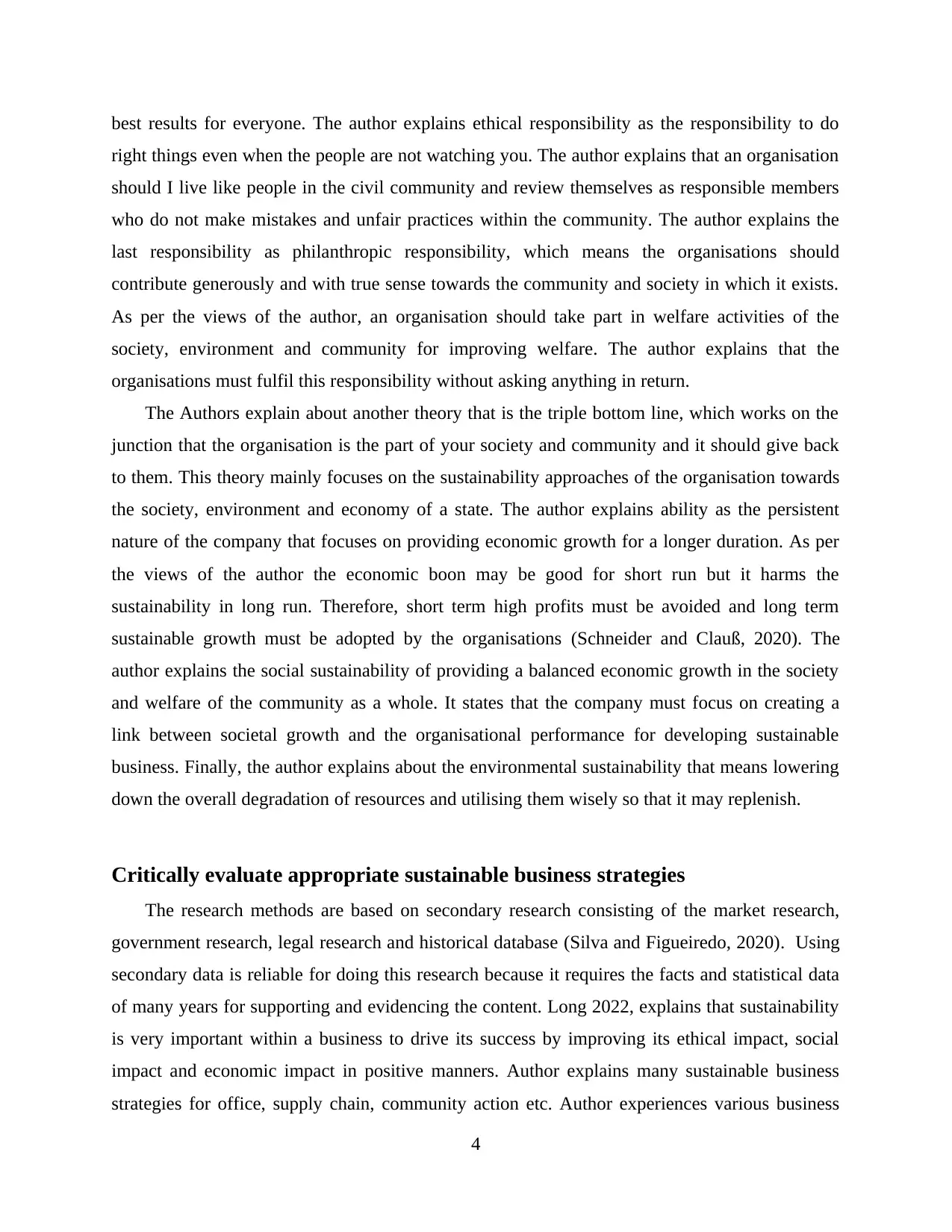
best results for everyone. The author explains ethical responsibility as the responsibility to do
right things even when the people are not watching you. The author explains that an organisation
should I live like people in the civil community and review themselves as responsible members
who do not make mistakes and unfair practices within the community. The author explains the
last responsibility as philanthropic responsibility, which means the organisations should
contribute generously and with true sense towards the community and society in which it exists.
As per the views of the author, an organisation should take part in welfare activities of the
society, environment and community for improving welfare. The author explains that the
organisations must fulfil this responsibility without asking anything in return.
The Authors explain about another theory that is the triple bottom line, which works on the
junction that the organisation is the part of your society and community and it should give back
to them. This theory mainly focuses on the sustainability approaches of the organisation towards
the society, environment and economy of a state. The author explains ability as the persistent
nature of the company that focuses on providing economic growth for a longer duration. As per
the views of the author the economic boon may be good for short run but it harms the
sustainability in long run. Therefore, short term high profits must be avoided and long term
sustainable growth must be adopted by the organisations (Schneider and Clauß, 2020). The
author explains the social sustainability of providing a balanced economic growth in the society
and welfare of the community as a whole. It states that the company must focus on creating a
link between societal growth and the organisational performance for developing sustainable
business. Finally, the author explains about the environmental sustainability that means lowering
down the overall degradation of resources and utilising them wisely so that it may replenish.
Critically evaluate appropriate sustainable business strategies
The research methods are based on secondary research consisting of the market research,
government research, legal research and historical database (Silva and Figueiredo, 2020). Using
secondary data is reliable for doing this research because it requires the facts and statistical data
of many years for supporting and evidencing the content. Long 2022, explains that sustainability
is very important within a business to drive its success by improving its ethical impact, social
impact and economic impact in positive manners. Author explains many sustainable business
strategies for office, supply chain, community action etc. Author experiences various business
4
right things even when the people are not watching you. The author explains that an organisation
should I live like people in the civil community and review themselves as responsible members
who do not make mistakes and unfair practices within the community. The author explains the
last responsibility as philanthropic responsibility, which means the organisations should
contribute generously and with true sense towards the community and society in which it exists.
As per the views of the author, an organisation should take part in welfare activities of the
society, environment and community for improving welfare. The author explains that the
organisations must fulfil this responsibility without asking anything in return.
The Authors explain about another theory that is the triple bottom line, which works on the
junction that the organisation is the part of your society and community and it should give back
to them. This theory mainly focuses on the sustainability approaches of the organisation towards
the society, environment and economy of a state. The author explains ability as the persistent
nature of the company that focuses on providing economic growth for a longer duration. As per
the views of the author the economic boon may be good for short run but it harms the
sustainability in long run. Therefore, short term high profits must be avoided and long term
sustainable growth must be adopted by the organisations (Schneider and Clauß, 2020). The
author explains the social sustainability of providing a balanced economic growth in the society
and welfare of the community as a whole. It states that the company must focus on creating a
link between societal growth and the organisational performance for developing sustainable
business. Finally, the author explains about the environmental sustainability that means lowering
down the overall degradation of resources and utilising them wisely so that it may replenish.
Critically evaluate appropriate sustainable business strategies
The research methods are based on secondary research consisting of the market research,
government research, legal research and historical database (Silva and Figueiredo, 2020). Using
secondary data is reliable for doing this research because it requires the facts and statistical data
of many years for supporting and evidencing the content. Long 2022, explains that sustainability
is very important within a business to drive its success by improving its ethical impact, social
impact and economic impact in positive manners. Author explains many sustainable business
strategies for office, supply chain, community action etc. Author experiences various business
4
⊘ This is a preview!⊘
Do you want full access?
Subscribe today to unlock all pages.

Trusted by 1+ million students worldwide
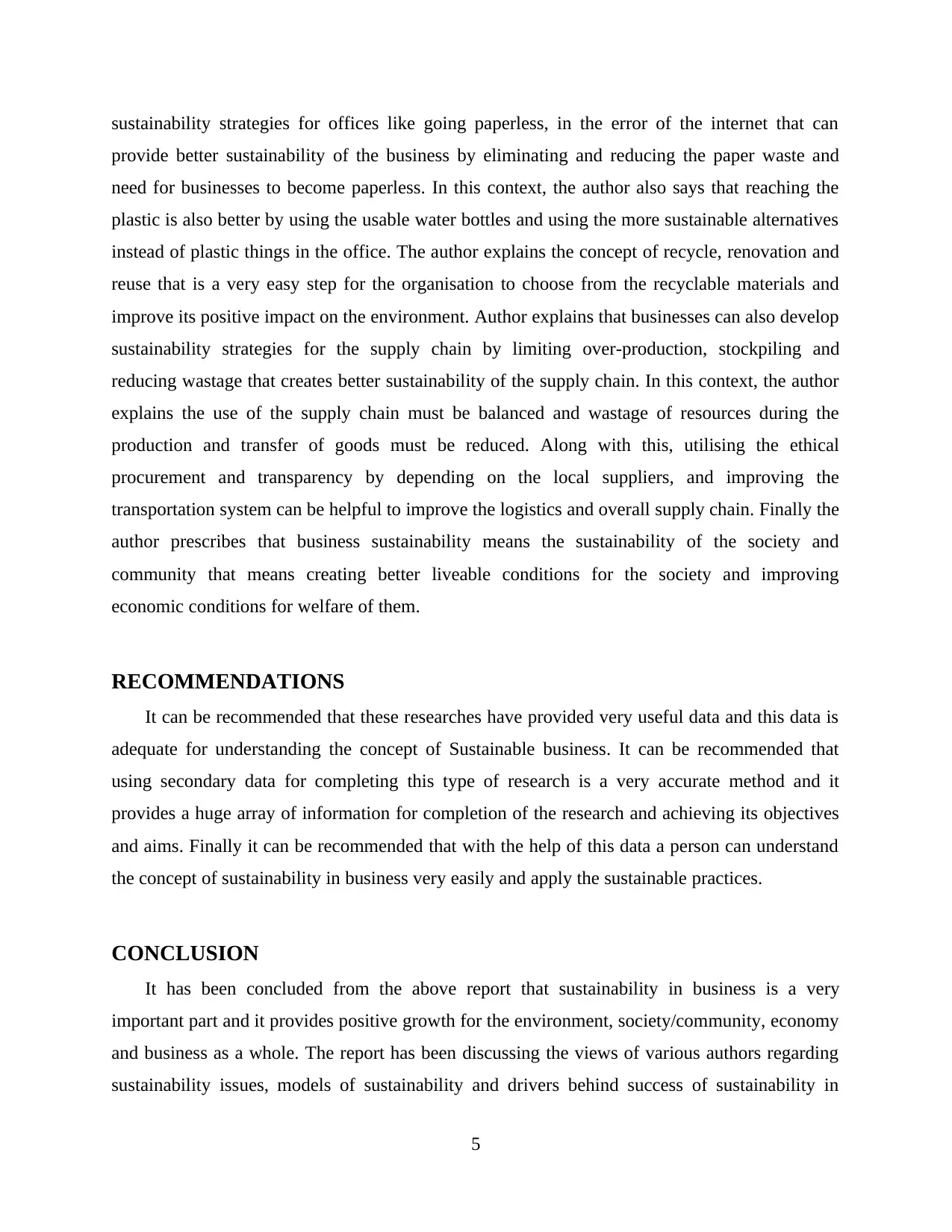
sustainability strategies for offices like going paperless, in the error of the internet that can
provide better sustainability of the business by eliminating and reducing the paper waste and
need for businesses to become paperless. In this context, the author also says that reaching the
plastic is also better by using the usable water bottles and using the more sustainable alternatives
instead of plastic things in the office. The author explains the concept of recycle, renovation and
reuse that is a very easy step for the organisation to choose from the recyclable materials and
improve its positive impact on the environment. Author explains that businesses can also develop
sustainability strategies for the supply chain by limiting over-production, stockpiling and
reducing wastage that creates better sustainability of the supply chain. In this context, the author
explains the use of the supply chain must be balanced and wastage of resources during the
production and transfer of goods must be reduced. Along with this, utilising the ethical
procurement and transparency by depending on the local suppliers, and improving the
transportation system can be helpful to improve the logistics and overall supply chain. Finally the
author prescribes that business sustainability means the sustainability of the society and
community that means creating better liveable conditions for the society and improving
economic conditions for welfare of them.
RECOMMENDATIONS
It can be recommended that these researches have provided very useful data and this data is
adequate for understanding the concept of Sustainable business. It can be recommended that
using secondary data for completing this type of research is a very accurate method and it
provides a huge array of information for completion of the research and achieving its objectives
and aims. Finally it can be recommended that with the help of this data a person can understand
the concept of sustainability in business very easily and apply the sustainable practices.
CONCLUSION
It has been concluded from the above report that sustainability in business is a very
important part and it provides positive growth for the environment, society/community, economy
and business as a whole. The report has been discussing the views of various authors regarding
sustainability issues, models of sustainability and drivers behind success of sustainability in
5
provide better sustainability of the business by eliminating and reducing the paper waste and
need for businesses to become paperless. In this context, the author also says that reaching the
plastic is also better by using the usable water bottles and using the more sustainable alternatives
instead of plastic things in the office. The author explains the concept of recycle, renovation and
reuse that is a very easy step for the organisation to choose from the recyclable materials and
improve its positive impact on the environment. Author explains that businesses can also develop
sustainability strategies for the supply chain by limiting over-production, stockpiling and
reducing wastage that creates better sustainability of the supply chain. In this context, the author
explains the use of the supply chain must be balanced and wastage of resources during the
production and transfer of goods must be reduced. Along with this, utilising the ethical
procurement and transparency by depending on the local suppliers, and improving the
transportation system can be helpful to improve the logistics and overall supply chain. Finally the
author prescribes that business sustainability means the sustainability of the society and
community that means creating better liveable conditions for the society and improving
economic conditions for welfare of them.
RECOMMENDATIONS
It can be recommended that these researches have provided very useful data and this data is
adequate for understanding the concept of Sustainable business. It can be recommended that
using secondary data for completing this type of research is a very accurate method and it
provides a huge array of information for completion of the research and achieving its objectives
and aims. Finally it can be recommended that with the help of this data a person can understand
the concept of sustainability in business very easily and apply the sustainable practices.
CONCLUSION
It has been concluded from the above report that sustainability in business is a very
important part and it provides positive growth for the environment, society/community, economy
and business as a whole. The report has been discussing the views of various authors regarding
sustainability issues, models of sustainability and drivers behind success of sustainability in
5
Paraphrase This Document
Need a fresh take? Get an instant paraphrase of this document with our AI Paraphraser
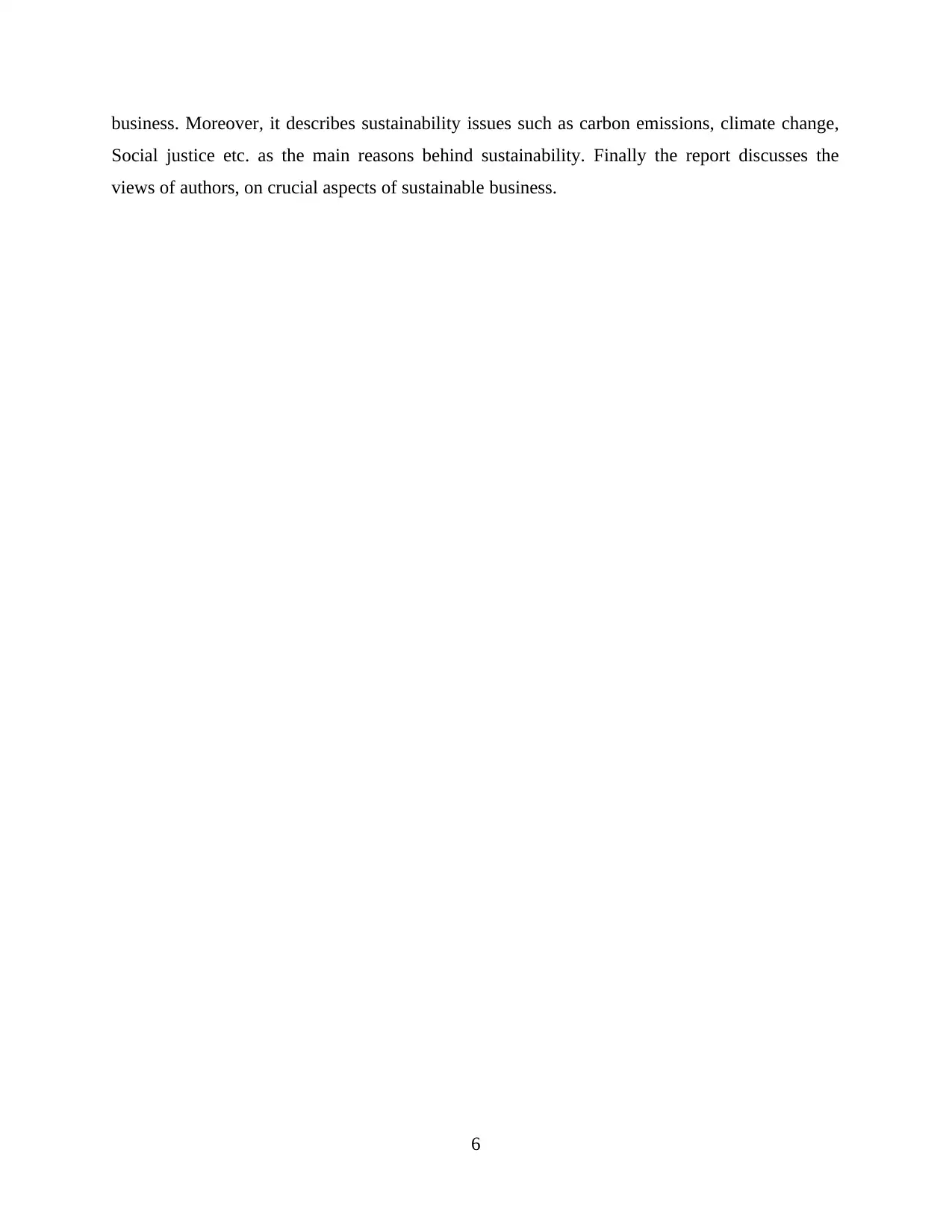
business. Moreover, it describes sustainability issues such as carbon emissions, climate change,
Social justice etc. as the main reasons behind sustainability. Finally the report discusses the
views of authors, on crucial aspects of sustainable business.
6
Social justice etc. as the main reasons behind sustainability. Finally the report discusses the
views of authors, on crucial aspects of sustainable business.
6
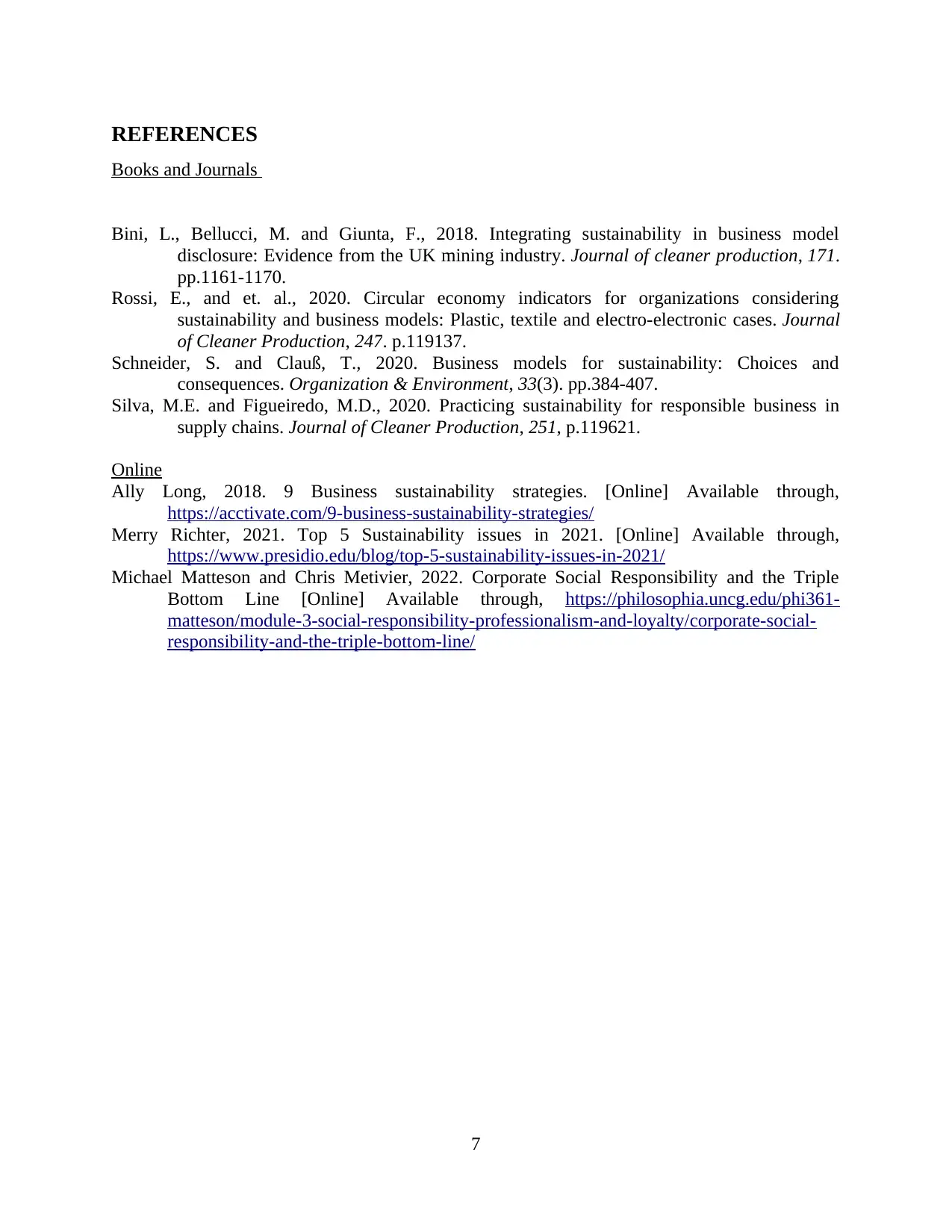
REFERENCES
Books and Journals
Bini, L., Bellucci, M. and Giunta, F., 2018. Integrating sustainability in business model
disclosure: Evidence from the UK mining industry. Journal of cleaner production, 171.
pp.1161-1170.
Rossi, E., and et. al., 2020. Circular economy indicators for organizations considering
sustainability and business models: Plastic, textile and electro-electronic cases. Journal
of Cleaner Production, 247. p.119137.
Schneider, S. and Clauß, T., 2020. Business models for sustainability: Choices and
consequences. Organization & Environment, 33(3). pp.384-407.
Silva, M.E. and Figueiredo, M.D., 2020. Practicing sustainability for responsible business in
supply chains. Journal of Cleaner Production, 251, p.119621.
Online
Ally Long, 2018. 9 Business sustainability strategies. [Online] Available through,
https://acctivate.com/9-business-sustainability-strategies/
Merry Richter, 2021. Top 5 Sustainability issues in 2021. [Online] Available through,
https://www.presidio.edu/blog/top-5-sustainability-issues-in-2021/
Michael Matteson and Chris Metivier, 2022. Corporate Social Responsibility and the Triple
Bottom Line [Online] Available through, https://philosophia.uncg.edu/phi361-
matteson/module-3-social-responsibility-professionalism-and-loyalty/corporate-social-
responsibility-and-the-triple-bottom-line/
7
Books and Journals
Bini, L., Bellucci, M. and Giunta, F., 2018. Integrating sustainability in business model
disclosure: Evidence from the UK mining industry. Journal of cleaner production, 171.
pp.1161-1170.
Rossi, E., and et. al., 2020. Circular economy indicators for organizations considering
sustainability and business models: Plastic, textile and electro-electronic cases. Journal
of Cleaner Production, 247. p.119137.
Schneider, S. and Clauß, T., 2020. Business models for sustainability: Choices and
consequences. Organization & Environment, 33(3). pp.384-407.
Silva, M.E. and Figueiredo, M.D., 2020. Practicing sustainability for responsible business in
supply chains. Journal of Cleaner Production, 251, p.119621.
Online
Ally Long, 2018. 9 Business sustainability strategies. [Online] Available through,
https://acctivate.com/9-business-sustainability-strategies/
Merry Richter, 2021. Top 5 Sustainability issues in 2021. [Online] Available through,
https://www.presidio.edu/blog/top-5-sustainability-issues-in-2021/
Michael Matteson and Chris Metivier, 2022. Corporate Social Responsibility and the Triple
Bottom Line [Online] Available through, https://philosophia.uncg.edu/phi361-
matteson/module-3-social-responsibility-professionalism-and-loyalty/corporate-social-
responsibility-and-the-triple-bottom-line/
7
⊘ This is a preview!⊘
Do you want full access?
Subscribe today to unlock all pages.

Trusted by 1+ million students worldwide
1 out of 9
Related Documents
Your All-in-One AI-Powered Toolkit for Academic Success.
+13062052269
info@desklib.com
Available 24*7 on WhatsApp / Email
![[object Object]](/_next/static/media/star-bottom.7253800d.svg)
Unlock your academic potential
Copyright © 2020–2025 A2Z Services. All Rights Reserved. Developed and managed by ZUCOL.





